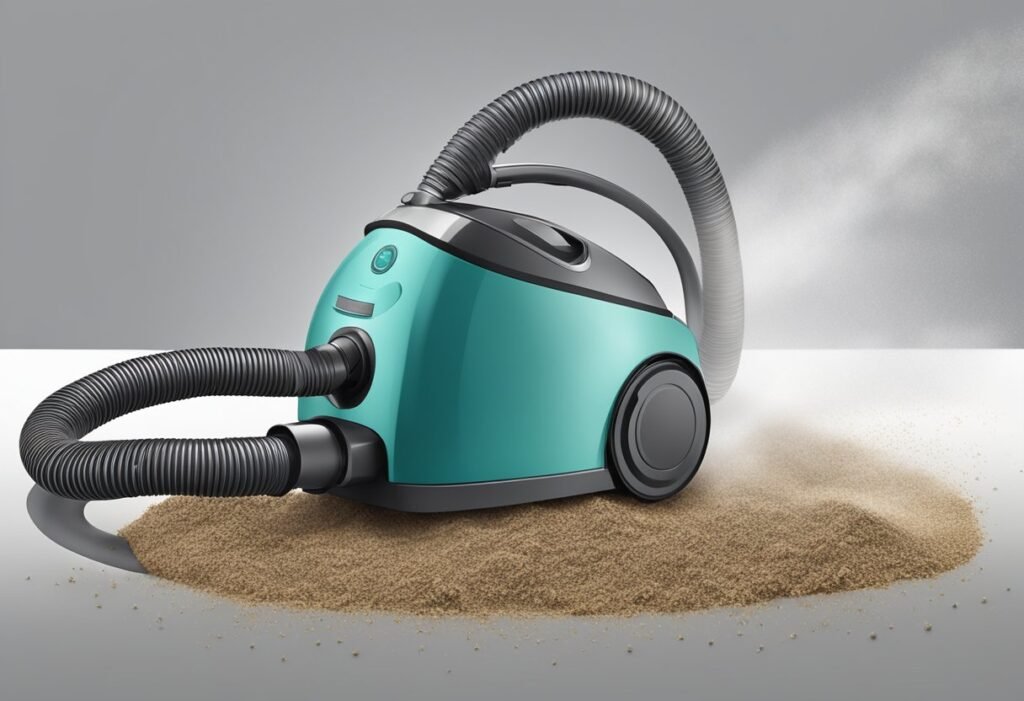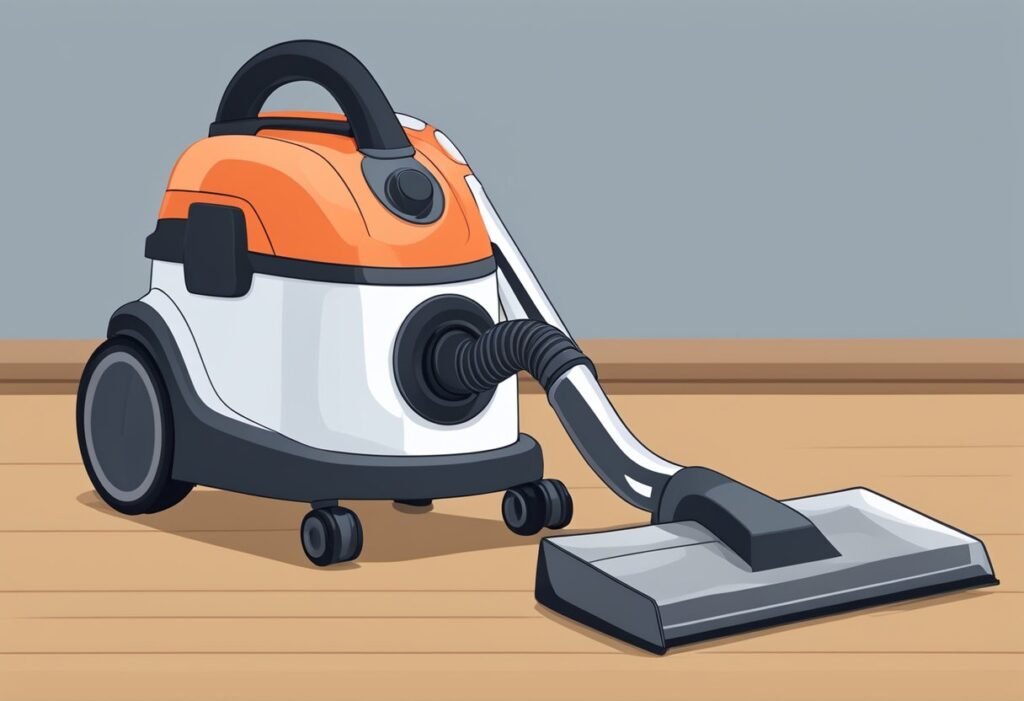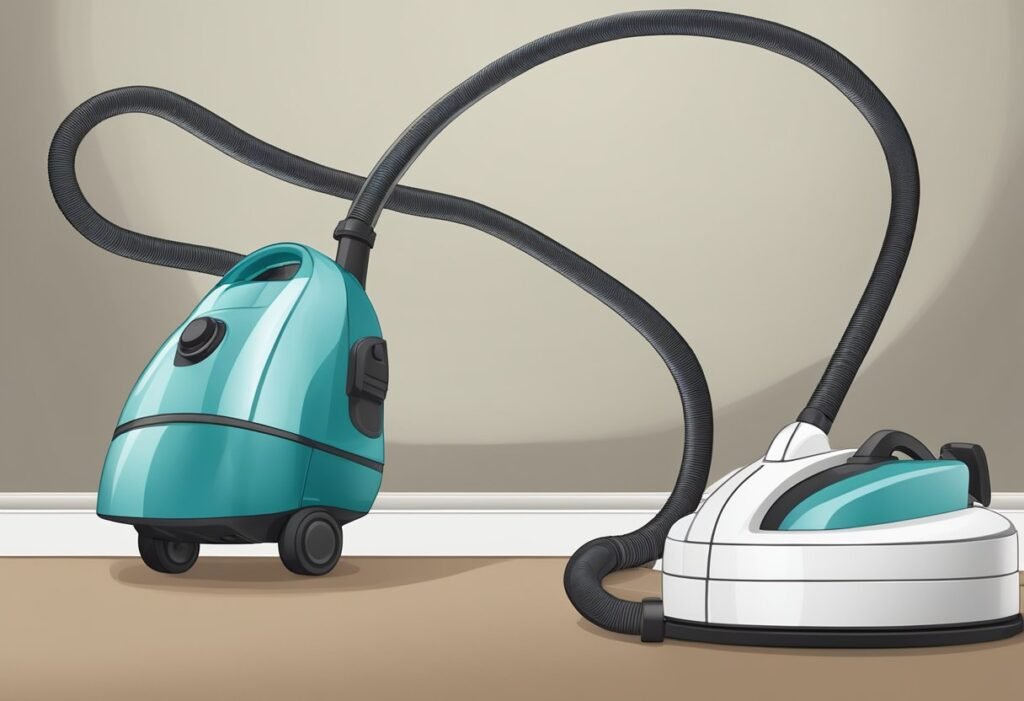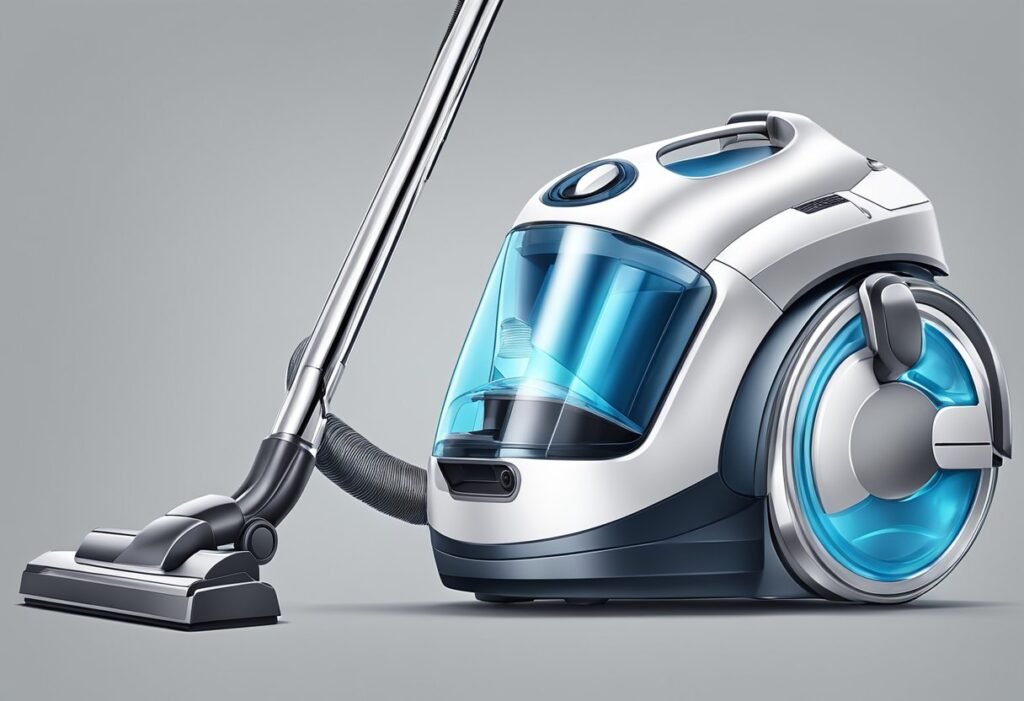A vacuum cleaner is a device that creates a partial vacuum, which sucks in air and anything else in its path, including dust, dirt, and debris. The suction power is created by an electric motor that drives a fan, which pulls air and dust particles through the vacuum cleaner’s body and into a collection container or bag. The fan in a vacuum operates under the same principles as a ceiling fan, except that it’s much more compact and powerful.
Knowing how a vacuum cleaner works can help you choose the right one for your needs and keep it running smoothly for years to come. In this article, we will explore the inner workings of a vacuum cleaner and explain how it creates suction, how it collects dirt and debris, and how to maintain it for optimal performance.
Table of Contents
Fundamental Principles of Vacuum Cleaners

Vacuum cleaners work on the principle of suction, which is a process that removes the air and any other substance that is lighter than the surrounding air. The process of suction is achieved by creating a pressure differential between the inside and outside of the vacuum cleaner. In this section, we will discuss the fundamental principles of vacuum cleaners that make them effective cleaning tools.
Airflow and Suction
The airflow and suction are two of the most important factors that determine the cleaning power of a vacuum cleaner. The airflow is the movement of air through the vacuum cleaner, while suction is the force that pulls the air and dust particles into the vacuum cleaner. The airflow and suction are created by an electric motor that drives a fan, which pulls air and dust particles through the vacuum cleaner’s body and into a collection container or bag.
Pressure Differentials
The pressure differential is the difference in pressure between the inside and outside of the vacuum cleaner. The pressure differential is created by the electric motor that drives the fan. As the fan rotates, it creates a low-pressure area inside the vacuum cleaner, which causes air to rush in through the intake port. The air then moves through the vacuum cleaner, picking up dust and debris along the way, before being expelled through the exhaust port.
Electric Motor Functionality
The electric motor is the heart of the vacuum cleaner. It drives the fan which creates the airflow and suction. The motor is typically located in the base of the vacuum cleaner and is connected to the fan by a drive belt. When the motor is turned on, it rotates the fan, which creates a low-pressure area inside the vacuum cleaner, causing air to rush in through the intake port.
In conclusion, the fundamental principles of vacuum cleaners are airflow, suction, pressure differentials, and electric motor functionality. These principles work together to create a powerful cleaning tool that is effective in removing dust and debris from carpets, floors, and other surfaces.
Main Components of a Vacuum Cleaner

A vacuum cleaner is a complex machine that is composed of several components that work together to remove dirt, dust, and debris from surfaces. Understanding these components is essential for anyone who wants to know how a vacuum cleaner works. Here are the main components of a vacuum cleaner:
Intake Port
The intake port is the opening at the bottom of the vacuum cleaner that allows it to suck in air and debris from the floor. The intake port is usually equipped with a rotating brush that agitates the carpet fibers to loosen dirt and dust. The brush is driven by a belt that is connected to the vacuum cleaner’s motor.
Exhaust Port
The exhaust port is the opening at the back or side of the vacuum cleaner that expels the filtered air back into the room. The exhaust port is usually equipped with a filter that traps dust and allergens.
Filter System
The filter system is one of the most important components of a vacuum cleaner. It is responsible for trapping dust, dirt, and allergens that are sucked up by the vacuum cleaner. There are several types of filters that are used in vacuum cleaners, including HEPA filters, foam filters, and paper filters. HEPA filters are the most effective at trapping tiny particles, such as pollen and pet dander.
Dust Bag or Canister
The dust bag or canister is where the dirt and dust that is sucked up by the vacuum cleaner is collected. Bagged vacuum cleaners use disposable bags that need to be replaced when they are full. Bagless vacuum cleaners use a canister that can be emptied into the trash when it is full. The dust bag or canister is usually located near the exhaust port and is connected to the intake port by a hose.
In summary, the main components of a vacuum cleaner include the intake port, exhaust port, filter system, and dust bag or canister. Understanding how these components work together is essential for anyone who wants to know how a vacuum cleaner works.
Types of Vacuum Cleaners
There are various types of vacuum cleaners, each with its unique mechanism and purpose. Let’s explore some common types:
Upright Vacuums
Upright vacuum cleaners are the most common and widely used type. They stand upright on wheels and come with a motorized brush that helps to agitate and loosen dirt and debris from carpets and rugs. These vacuum cleaners are ideal for cleaning large areas and can be used on both carpets and hard floors. They come with a variety of features such as adjustable height settings, different suction power settings, and attachments for cleaning upholstery, stairs, and crevices.
Canister Vacuums
Canister vacuum cleaners consist of a canister that houses the motor and dustbin and a long hose with a wand and nozzle. The canister is usually placed on the ground, and the user holds the wand to clean the floor or other surfaces. These vacuum cleaners are versatile and can be used to clean carpets, hard floors, upholstery, stairs, and crevices. They are also quieter than upright vacuums and are easier to maneuver around furniture.
Handheld Vacuums
Handheld vacuum cleaners are small and lightweight, making them ideal for quick cleanups and hard-to-reach areas such as stairs, upholstery, and car interiors. They are battery-powered and do not require a cord, making them easy to use and store. However, they are not as powerful as other types of vacuum cleaners and are not suitable for cleaning large areas.
Robotic Vacuums
Robotic vacuum cleaners are the latest innovation in vacuum technology. They are small, disc-shaped devices that automatically clean floors without human intervention. They use sensors and mapping technology to navigate around obstacles and avoid falling down stairs. They are ideal for people who do not have the time or energy to clean their floors regularly.
Stick Vacuums
Stick vacuum cleaners are lightweight and slim, making them easy to maneuver around furniture and tight spaces. They are battery-powered and do not require a cord, making them easy to use and store. They are ideal for quick cleanups and hard-to-reach areas such as stairs, upholstery, and car interiors. However, they are not as powerful as other types of vacuum cleaners and are not suitable for cleaning large areas.
Vacuum Cleaner Attachments and Accessories

When it comes to cleaning, vacuum cleaners are one of the most useful tools in the arsenal. However, to get the most out of your vacuum cleaner, it’s important to have the right attachments and accessories. Here are some of the most common attachments that come with vacuum cleaners:
Crevice Tool
The crevice tool is a long, narrow attachment that is perfect for getting into tight spaces. It’s great for cleaning between couch cushions, along baseboards, and in other hard-to-reach areas. The crevice tool is designed to fit into tight spaces and has a narrow opening that allows it to suck up dirt and debris.
Dusting Brush
The dusting brush is a soft-bristled attachment that is perfect for dusting furniture, lampshades, and other delicate surfaces. It’s also great for cleaning blinds and other hard-to-reach areas. The soft bristles help to gently remove dust and dirt without scratching or damaging surfaces.
Upholstery Nozzle
The upholstery nozzle is a wide, flat attachment that is designed to clean upholstery and other soft surfaces. It’s great for cleaning couches, chairs, and other furniture. The wide nozzle allows you to cover a large area quickly, and the soft bristles help to remove dirt and debris without damaging the fabric.
Extension Wand
The extension wand is a long, straight attachment that allows you to reach high places without having to climb on a ladder. It’s great for cleaning ceilings, ceiling fans, and other hard-to-reach areas. The extension wand is also great for getting under furniture and other low-lying areas.
Overall, having the right attachments and accessories can make a big difference when it comes to cleaning with a vacuum cleaner. By using the right attachment for the job, you can clean more effectively and efficiently, and keep your home looking its best.
Cleaning Process Of Vacuum Cleaner

When a vacuum cleaner is turned on, it goes through a series of steps to clean the floor. The cleaning process involves three main components: Brush Roll and Beater Bar, Suction and Collection, and Filtration and Exhaust.
Brush Roll and Beater Bar
The Brush Roll and Beater Bar are the first components of the cleaning process. They are responsible for agitating the carpet fibers and loosening the dirt and debris. The Brush Roll is a cylindrical brush that rotates on the bottom of the vacuum cleaner. The Beater Bar is a bar with bristles that rotates rapidly and beats the carpet to loosen the dirt.
Suction and Collection
The second component of the cleaning process is Suction and Collection. The suction is created by an electric motor that drives a fan, which pulls air and dust particles through the vacuum cleaner’s body and into a collection container or bag. The dirt and debris are then collected in a bag or container that is attached to the vacuum cleaner. The suction power of the vacuum cleaner is determined by the strength of the motor and the design of the fan.
Filtration and Exhaust
The third component of the cleaning process is Filtration and Exhaust. As the incoming air and debris are drawn into the vacuum, they pass through one or more filters. These filters, often including HEPA filters, capture and trap fine particles like dust, allergens, and microorganisms, ensuring that only clean air is released back into the environment. The exhaust air is usually released through the back of the vacuum cleaner.
In conclusion, the cleaning process of a vacuum cleaner involves three main components: Brush Roll and Beater Bar, Suction and Collection, and Filtration and Exhaust. Each component plays a critical role in ensuring that the vacuum cleaner effectively cleans the floor and releases clean air back into the environment.
Maintenance and Troubleshooting
Regular maintenance of a vacuum cleaner is essential to keep it running smoothly and efficiently. Here are some tips to help you maintain your vacuum cleaner:
Regular Cleaning
It is important to clean your vacuum cleaner regularly to ensure that it is picking up dirt and debris effectively. You should empty the dustbin or replace the vacuum bag when it is full, and clean the brush roll and the filters. If the brush roll is clogged with hair or other debris, it can cause the vacuum cleaner to lose suction. You can use a pair of scissors to cut away any hair or string that is wrapped around the brush roll.
Filter Replacement
The filters in a vacuum cleaner are designed to trap dust and other small particles. Over time, these filters can become clogged, which can reduce the suction power of the vacuum cleaner. It is important to replace the filters regularly to ensure that the vacuum cleaner is working effectively. The frequency of filter replacement will depend on how often you use your vacuum cleaner, but a good rule of thumb is to replace the filters every three to six months.
Blockage Removal
If your vacuum cleaner is not picking up dirt and debris effectively, it may be because there is a blockage somewhere in the system. You should check the hose, the dustbin, and the filters for any blockages. If you find a blockage, you can use a long, thin object like a coat hanger or a pipe cleaner to remove it. It is important to be gentle when removing blockages to avoid damaging the vacuum cleaner.
By following these maintenance and troubleshooting tips, you can keep your vacuum cleaner running smoothly and effectively for years to come.
Advancements in Vacuum Cleaner Technology

Vacuum cleaners have come a long way since their inception, and advancements in technology have made them more efficient and user-friendly. In this section, we will discuss some of the latest developments in vacuum cleaner technology.
Cordless Convenience
Cordless vacuum cleaners have become increasingly popular in recent years due to their convenience and ease of use. These vacuums are powered by rechargeable batteries, allowing users to move around freely without the hassle of cords and outlets.
One of the most significant benefits of cordless vacuum cleaners is their portability. They are lightweight and easy to maneuver, making them ideal for cleaning stairs, upholstery, and hard-to-reach areas. Additionally, many models come with detachable handheld vacuums, which are perfect for cleaning cars and other small spaces.
HEPA Filtration
HEPA (High-Efficiency Particulate Air) filtration is a technology that captures particles as small as 0.3 microns, making it an essential feature for those suffering from allergies or respiratory issues. HEPA filters are made up of dense layers of fine mesh that trap dust, pollen, and other allergens, preventing them from being released back into the air.
Many vacuum cleaners now come equipped with HEPA filters, making them an excellent choice for those with allergies or asthma. Some models even have multiple filters, ensuring that the air expelled from the vacuum is as clean as possible.
Automated and Smart Features
Vacuum cleaners with automated and smart features have become increasingly popular in recent years. These vacuums can be programmed to clean on a schedule, allowing users to set it and forget it. Some models even have sensors that detect when a room needs cleaning and will automatically start cleaning.
Smart vacuum cleaners can also be controlled via a smartphone app, allowing users to start and stop the vacuum remotely. Additionally, some models have voice-activated controls, making it even easier to operate.
Final Words
Vacuum cleaners work by creating suction to remove dirt and debris from floors, carpets, and other surfaces. They consist of several components, including an electric motor, a fan, and a collection container or bag.
When choosing a vacuum cleaner, it is important to consider factors such as suction power, filtration, and maneuverability. Bagless models may be more convenient, but they require more maintenance and may not be ideal for individuals with allergies or asthma.
Regular maintenance, such as cleaning the filter and emptying the collection container or bag, can help ensure the vacuum cleaner continues to operate effectively. Additionally, using the appropriate attachments for different surfaces and cleaning tasks can help maximize the vacuum’s cleaning power.
Overall, vacuum cleaners are an essential tool for maintaining a clean and healthy home. By understanding how they work and selecting the right model for your needs, you can ensure your floors and surfaces remain free of dirt and debris.



